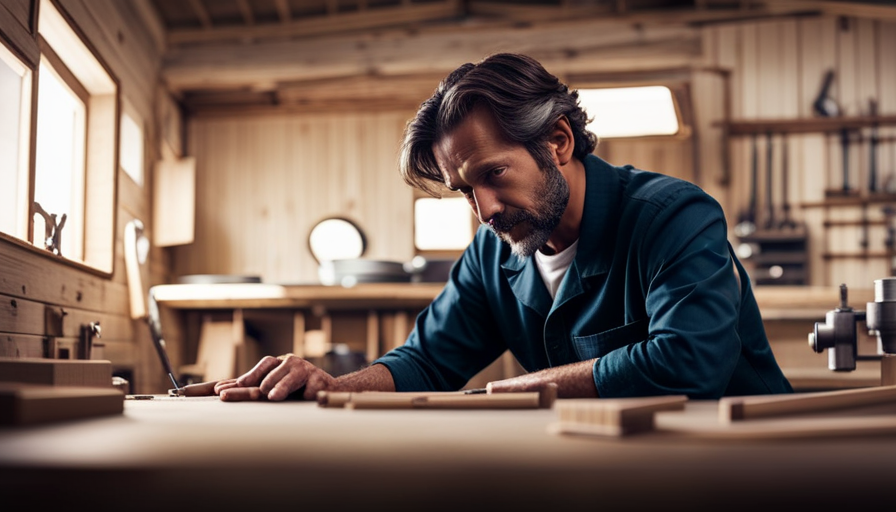As I embark on the journey of building a small house, I am faced with a crucial question: How many axles does my trailer need? Axles are the foundation of any mobile home, crucial for ensuring balance and stability while on the move. Similar to how a strong spine supports the human body, the number of axles determines the capability of my tiny house to navigate various terrains and handle different road conditions.
To make an informed decision, I must consider several factors. First and foremost, understanding the weight and size of my tiny house is crucial. This knowledge will help me determine the Gross Vehicle Weight Rating (GVWR) required for my trailer.
Additionally, assessing the terrain and road conditions where I plan to travel is essential.
Another critical consideration is my towing vehicle’s capacity. The axle configuration must align with its capabilities to ensure smooth towing without straining the vehicle’s engine or suspension system.
In this article, we will delve into these factors in detail, consult professionals and experts, research local regulations and permits, and ultimately make an informed decision about how many axles are needed for our tiny house trailer.
Let’s dive in!
Key Takeaways
- The number of axles on a tiny house trailer is crucial for stability and safety while towing.
- The weight and size of the tiny house, as well as the terrain and road conditions, determine the number of axles needed.
- Proper weight distribution and even load distribution across all axles improve maneuverability and reduce strain.
- Consulting professionals, researching local road regulations, and obtaining permits are important for determining the appropriate number of axles and ensuring compliance with legal requirements.
Understanding the Weight and Size of Your Tiny House
To determine the number of axles you’ll need on your tiny house trailer, it’s crucial to understand the weight and size of your humble abode.
Weight and size considerations play a significant role in determining the appropriate number of axles for your tiny house trailer. The towing vehicle’s capacity is also a critical factor to take into account.
Firstly, consider the weight of your tiny house. This includes not only the actual weight of the structure itself but also all its contents, such as furniture, appliances, and personal belongings. You should calculate this total weight accurately to ensure that it doesn’t exceed the towing vehicle’s capacity.
Secondly, evaluate the size of your tiny house. The length, width, and height dimensions will impact how stable and balanced your tiny house trailer needs to be during transportation. A longer or wider structure might require additional axles for better weight distribution and improved stability on the road.
By considering both the weight and size considerations along with the towing vehicle’s capacity, you can determine how many axles are necessary for your specific situation. Understanding these factors will allow you to make an informed decision regarding axle placement on your tiny house trailer without compromising safety or performance during transit.
Determining the Gross Vehicle Weight Rating (GVWR)
Determining the GVWR is crucial in determining the appropriate number of axles for a small dwelling on wheels. The Gross Vehicle Weight Rating (GVWR) refers to the maximum weight that a trailer can safely carry, including its own weight and the weight of everything loaded onto it.
To calculate the GVWR, you need to consider several factors. First, determining the trailer weight capacity is important. This involves considering not only the weight of your tiny house but also any additional items you plan to load onto it, such as furniture or appliances. It’s essential to ensure that your chosen trailer can handle this combined weight without exceeding its GVWR.
Another factor to consider is the weight distribution. This is crucial for maintaining stability while towing. You want to distribute the weight evenly across all axles to prevent overloading any single axle. By doing so, you can improve maneuverability and reduce strain on each individual axle.
Accurately determining your tiny house’s GVWR and understanding how it relates to axle count and distribution is important for a safe and well-balanced towing experience. Assessing these factors will set you up for success when assessing terrain and road conditions in subsequent sections without compromising safety or stability during transportation.
Assessing the Terrain and Road Conditions
Navigating through various terrains and road conditions is like embarking on a thrilling adventure, where every twist and turn brings excitement and challenges that test the limits of your mobile abode’s capabilities.
When assessing road conditions for your tiny house trailer, it’s crucial to consider environmental factors that could impact the performance of your home on wheels.
Firstly, you need to evaluate the type of terrain you’ll be encountering. Is it mostly flat or hilly? Will you be traveling through rough, unpaved roads or smooth highways? These factors play a significant role in determining the number of axles needed for your tiny house trailer. Generally, trailers with multiple axles provide better stability and weight distribution on uneven terrains.
Additionally, weather conditions can greatly affect road surfaces. Heavy rain can result in slippery roads, while snow and ice create hazardous driving conditions. It’s essential to choose a trailer with adequate axles to ensure optimal control and safety in such situations.
Considering these road conditions and environmental factors will help you determine the appropriate number of axles for your tiny house trailer.
Transitioning into considering your towing vehicle’s capacity, it’s important to analyze its specifications to ensure compatibility between the vehicle and trailer setup without compromising safety or performance.
Consider Your Towing Vehicle’s Capacity
When considering towing a tiny house, it’s crucial to determine the towing capacity of your vehicle. This will ensure that your vehicle is capable of safely handling the weight of your tiny house. It’s important to carefully assess and confirm that your vehicle can handle the load before embarking on any long journeys or road trips with your tiny house in tow.
Determine the Towing Capacity of Your Vehicle
To accurately determine the towing capacity of your vehicle, it’s important to consider the number of axles needed on a tiny house trailer. The number of axles directly affects the weight distribution and stability while towing. Here are four key factors to keep in mind when determining the towing capacity and choosing an appropriate trailer size:
-
Gross Vehicle Weight Rating (GVWR): This is the maximum weight your vehicle can safely tow, including both the weight of the trailer and its contents.
-
Tongue Weight: This is the downward force exerted on the hitch by the trailer. It should typically be around 10-15% of the total trailer weight.
-
Trailer Brakes: Ensure that your vehicle has a braking system capable of handling the added weight and stopping distance.
-
Suspension System: Consider upgrading your suspension to handle increased load.
By considering these factors, you can ensure that your vehicle can safely handle the weight of your tiny house without compromising safety or performance.
Ensure Your Vehicle Can Safely Handle the Weight of Your Tiny House
Make sure your vehicle is equipped to handle the weight of your tiny house – can it safely carry the load? When towing a tiny house, it’s crucial to consider weight distribution and trailer suspension. The weight of your tiny house must be evenly distributed on the trailer to ensure stability during transportation. Uneven weight distribution can cause swaying or even lead to accidents. Additionally, check if your vehicle’s suspension system can handle the added weight. Excessive strain on the suspension can result in reduced control and potentially damage your vehicle over time. To help you visualize this, take a look at the table below:
| Axle Configuration | Weight Capacity |
|---|---|
| Single axle | Up to 7,000 lbs |
| Tandem axles | Up to 14,000 lbs |
| Triple axles | Up to 21,000 lbs |
Understanding axle configurations is essential for determining how many axles you need on your tiny house trailer. It ensures that you choose an appropriate configuration based on the weight of your tiny house and provides optimal support during transportation.
Understanding Axle Configurations
You should consider the axle configurations for your tiny house trailer to determine how many axles you need, which will impact its stability and weight distribution. Understanding weight distribution is crucial when building a tiny house on wheels. It ensures that the load is evenly distributed across all the axles, preventing excessive stress on any one point and maintaining balance while towing. Choosing the right suspension system is also essential as it helps absorb shocks and vibrations during travel.
When it comes to axle configurations, there are several options to choose from:
-
Single Axle: This configuration consists of a single axle located at the center of the trailer. It provides basic support but may not be suitable for heavy or larger tiny houses due to limited weight capacity.
-
Tandem Axle: With two axles positioned in tandem, this configuration offers increased stability and weight capacity compared to a single axle setup. It distributes the weight more evenly, reducing strain on individual components.
-
Triple Axle: This setup features three axles strategically placed along the length of the trailer. It provides even higher weight capacity and enhanced stability, making it ideal for larger tiny houses or those with heavier furnishings.
Considering these axle configurations will help ensure proper weight distribution and stability for your tiny house trailer. Evaluating the stability and maneuverability of your chosen configuration is important before moving on to other considerations in building your dream home on wheels.
Evaluating the Stability and Maneuverability
When evaluating the stability of different axle configurations for a tiny house trailer, it’s crucial to consider various factors. These include the weight distribution and load capacity of each axle, as well as the overall design and construction of the trailer.
Additionally, maneuverability and ease of towing should be taken into account. Factors such as turning radius and responsiveness are important considerations.
By carefully assessing these aspects, one can determine the optimal axle configuration that provides both stability and maneuverability for their specific needs.
Assess the Stability of Different Axle Configurations
To properly assess the stability of different axle configurations, it’s important to consider how many axles your tiny house trailer needs. Evaluating stability involves assessing weight distribution and ensuring that the trailer remains balanced while in motion.
The number of axles plays a crucial role in maintaining stability, as they distribute the weight evenly across the trailer. A single-axle configuration may be suitable for smaller and lighter tiny houses, but it can lead to reduced stability and increased sway during towing.
On the other hand, a dual-axle or even triple-axle configuration provides better stability by distributing the weight more evenly. This reduces swaying and enhances control while towing.
Considering these factors will help you determine the appropriate number of axles for your tiny house trailer, ensuring both stability and ease of towing are achieved seamlessly.
Consider the Maneuverability and Ease of Towing
Considering the maneuverability and ease of towing, how can you ensure that your tiny house trailer is easy to navigate in tight spaces?
When it comes to maneuverability benefits, opting for a tandem axle configuration can greatly enhance the handling capabilities of your tiny house trailer. With two axles instead of one, weight is distributed more evenly across the trailer, reducing the risk of swaying or fishtailing while towing. Additionally, having four wheels on the ground provides better traction and stability during turns and maneuvers.
However, it’s important to acknowledge the towing challenges that come with multiple axles. Turning radius may be affected due to increased length and width of the trailer, restricting your ability to navigate sharp corners or narrow paths. To mitigate these issues, consulting with professionals and experts in tiny house construction can provide valuable insights into designing a trailer that balances both maneuverability and stability.
Consulting with Professionals and Experts
When considering the stability and maneuverability of a tiny house trailer, it’s crucial to seek advice from professionals in the field. Trailer manufacturers or builders have extensive knowledge and experience in designing trailers that can handle specific loads and provide optimal stability.
Additionally, consulting with experienced tiny house owners or builders can offer valuable insights into the practical aspects of towing and maneuvering a tiny house on different terrains. By seeking advice from these experts, you can ensure that your tiny house trailer is designed to meet your specific needs while maintaining safety and ease of use.
Seek Advice from Trailer Manufacturers or Builders
For optimal guidance on axle requirements for your tiny house trailer, consult with experienced trailer manufacturers or builders. They’ve got the expertise and knowledge to advise you on the number of axles needed based on the weight and size of your tiny house. Here are four reasons why seeking advice from these professionals is crucial:
-
Expertise: Trailer manufacturers or builders have extensive knowledge about trailers and can provide accurate information specific to your tiny house.
-
Compliance with regulations: They’re well-versed in local transportation regulations, ensuring that your trailer meets all legal requirements for safe and efficient travel.
-
Customization options: With their experience, they can suggest customization options that align with your needs, maximizing functionality and safety.
-
Cost-effectiveness: By consulting professionals, you can avoid costly mistakes in choosing the wrong axles, saving both time and money.
By consulting experienced tiny house owners or builders who’ve successfully built their own homes, you can gain valuable insights into axle requirements without repeating previous steps.
Consult with Experienced Tiny House Owners or Builders
Seeking advice from seasoned tiny house owners or builders can provide valuable insights into the axle requirements for your compact home on wheels. When consulting with professionals, it’s important to gather information regarding the weight distribution of your tiny house and the specific terrain you plan to traverse.
Experienced tiny house owners can offer firsthand knowledge about their own trailers, including the number of axles they use and any challenges they encountered during transportation. Builders who specialize in tiny houses can also provide expert guidance based on their extensive experience constructing mobile homes.
By seeking advice from these individuals, you can ensure that your trailer has the appropriate number of axles to support the weight and dimensions of your tiny house while maintaining stability and maneuverability on various road conditions.
Transitioning into researching local road regulations and permits, it’s crucial to comply with these legal requirements to ensure a safe and hassle-free journey for your tiny home.
Researching Local Road Regulations and Permits
When towing a tiny house, it’s crucial to understand the legal requirements involved. This includes knowing the number of axles needed on the trailer and ensuring compliance with road regulations.
Additionally, researching permits and restrictions for oversized loads is essential to avoid any potential legal issues or obstacles during transport.
Understand the Legal Requirements for Towing a Tiny House
To legally tow a tiny house, you’ll need to understand the number of axles required on the trailer. Evaluating towing safety and understanding trailer weight distribution are crucial aspects in this process.
The number of axles needed depends on the total weight of your tiny house. Generally, a single axle can support up to 3,000 pounds, while two axles can handle up to 6,000 pounds. However, if your tiny house exceeds these weight limits or if you plan to travel long distances, it’s recommended to consider triple axle trailers that can support heavier loads with better stability and control.
It’s important to consult local road regulations and permits as they may have specific requirements regarding the number of axles based on your tiny house’s size and weight. This will ensure compliance with legal requirements for towing oversized loads without compromising safety or risking fines and penalties.
Research Permits and Restrictions for Oversized Loads
Make sure you dig deep and uncover the hidden gems of permit requirements and restrictions for moving your oversized load. Researching road restrictions is crucial to ensure a smooth journey for your tiny house.
Start by contacting local transportation departments or highway authorities to gather information about any specific regulations that may apply to your area. Additionally, consult state and federal guidelines regarding weight limits, height restrictions, and travel time restrictions.
Obtaining necessary permits is another essential step in this process. Determine which permits are required for transporting an oversized load and carefully follow the application procedures. Remember to allow ample time for processing these permits as they may take longer than expected.
Understanding the road restrictions and obtaining all necessary permits will help you stay compliant while towing your tiny house on a trailer.
Now that you’ve researched the permits and restrictions, it’s time to consider budget considerations when building a tiny house trailer.
Budget Considerations
Consider the budget and opt for the number of axles that will provide you with peace of mind while keeping your financial stress at bay. When it comes to tiny house trailers, budget considerations play a crucial role in determining the number of axles needed. The cost considerations and space limitations should be carefully evaluated to make an informed decision.
To help visualize the different options available, I have created a table below:
| Number of Axles | Cost | Space Requirements |
|---|---|---|
| 1 | $ | Less |
| 2 | $$ | Moderate |
| 3 | $$$ | More |
| 4+ | $$$$ | Extensive |
Choosing a single axle setup is the most cost-effective option as it requires less material and has lower maintenance costs. However, it may not provide sufficient stability or weight distribution for larger tiny houses.
Opting for a dual axle setup offers better stability and weight distribution compared to a single axle. It also allows for increased load capacity without sacrificing maneuverability.
For those with larger budgets and heavier loads, three or more axles might be necessary. These setups provide even greater stability, weight distribution, and load capacity but come at a higher cost and require more space.
Considering these factors will help you make an informed decision about how many axles are appropriate for your tiny house trailer.
Making an Informed Decision
When it comes to deciding on the perfect number of axles for your compact home on wheels, you’ll want to be well-informed. Evaluating the cost and considering the environmental impact are crucial factors in making an informed decision.
Here are some key points to consider:
-
Weight Distribution: The weight of your tiny house should be evenly distributed across the axles to prevent excessive strain on any one axle. This will ensure stability and longevity of your trailer.
-
Road Safety: Having multiple axles improves road safety by providing better traction and braking capabilities. It also helps in maintaining control during sharp turns or sudden maneuvers.
-
Load Capacity: Each axle has a specific load capacity that should align with the weight of your tiny house. Exceeding this limit can lead to damage or even failure of the axles.
-
Environmental Impact: Using more axles may increase fuel consumption and carbon emissions due to added weight. However, having additional axles could also decrease wear and tear on roads, reducing overall maintenance costs.
Considering these factors will help you determine how many axles you need for your tiny house trailer while balancing cost effectiveness and environmental impact.
Frequently Asked Questions
Are there any specific regulations or permits I need to consider when towing a tiny house trailer?
When towing a tiny house trailer, there are specific regulations and permits you need to consider.
These regulations vary depending on your location, but common challenges faced when towing tiny houses include weight restrictions, height restrictions, and proper lighting and signaling requirements.
It’s important to research and comply with the specific regulations for towing tiny houses in your area to ensure a safe and legal journey.
How can I determine the weight and size of my tiny house in order to choose the appropriate number of axles?
To determine the weight and size of my tiny house for choosing the appropriate number of axles, I need to gather accurate measurements and estimate the total load.
Start by measuring the length, width, and height of your tiny house. Calculate the weight by summing up the weights of all components like walls, roof, furniture, and appliances. Consider any additional weight from water tanks or storage.
Once you have these details, consult a trailer manufacturer or engineer to determine the suitable number of axles based on weight distribution and safety requirements.
What factors should I consider when assessing the terrain and road conditions that my tiny house trailer will be traveling on?
Assessing terrain conditions and road conditions are crucial for ensuring the stability of your tiny house trailer. Factors to consider include the incline or slope of the terrain, presence of potholes or uneven surfaces, and weather conditions like rain or snow.
Conduct a thorough trailer stability analysis by examining suspension systems, weight distribution, and tire grip. This technical evaluation will help determine the appropriate number of axles needed for optimal performance and safety on various terrains and road conditions.
How do I determine the towing capacity of my vehicle and ensure it is compatible with the weight of my tiny house trailer?
To determine the towing capacity of my vehicle and ensure it’s compatible with the weight of my tiny house trailer, I need to conduct a thorough assessment.
Firstly, I must determine the maximum weight my vehicle can safely tow by referring to its specifications or consulting the manufacturer.
Then, I should assess the weight and size of my tiny house trailer, including any additional cargo.
By comparing these factors, I can ensure that my vehicle has sufficient towing capacity for safe transportation.
Are there any professionals or experts that I should consult with before making a decision on the number of axles for my tiny house trailer?
Before making a decision on the number of axles for your tiny house trailer, it’s crucial to consult with professionals and experts in the field. These knowledgeable individuals can provide valuable insights based on their expertise and experience.
Their consultation will ensure that you make an informed decision regarding the axle configuration, taking into consideration factors such as weight distribution, towing capacity, and overall safety.
Don’t underestimate the importance of seeking professional advice when making this vital decision.
Conclusion
After carefully considering the weight, size, and road conditions, it’s clear that having multiple axles on a tiny house trailer is unnecessary.
The technical requirements may suggest otherwise, but in reality, one axle can handle the load just fine.
It’s ironic that something as small as a tiny house would need such complex considerations. But hey, who said living small meant making simple decisions?
So go ahead and make your choice wisely, because even in the world of tiny houses, every decision matters.
Hi, I’m Emma. I’m the Editor in Chief of Tiny House 43, a blog all about tiny houses. While tree houses are often associated with childhood, they can be the perfect adult retreat. They offer a cozy space to relax and unwind, surrounded by nature. And since they’re typically built on stilts or raised platforms, they offer stunning views that traditional homes simply can’t match. If you’re looking for a unique and romantic getaway, a tree house tiny house might just be the perfect option.










